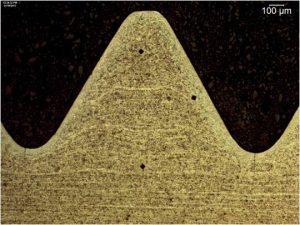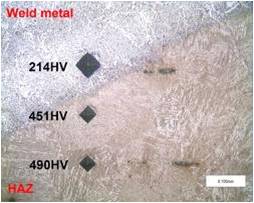Several forms of hardness testing are routinely used as a means of quality control and verification of the mechanical properties of materials, including most commonly used metal products, plastics and rubber. Microhardness testing proves very useful when parts are too small for Rockwell or Brinell testing, and it can also be used to evaluate the quality of case hardened components, check for decarburization, carburization and the condition of the weld and heat affected zones in welded parts.
 The photo at right shows a Vicker’s microhardness survey in a case hardened gear. Microhardness surveys are generally conducted within a couple of thousandths of inch from the surface and progress toward the core.
The photo at right shows a Vicker’s microhardness survey in a case hardened gear. Microhardness surveys are generally conducted within a couple of thousandths of inch from the surface and progress toward the core.
Obtained microhardness values can be converted to approximate equivalent Rockwell and Brinell values using conversion tables such as those available in ASTM E140.
The use of microhardness testing is crucial to the evaluation of threaded fasteners. Following the guidelines in SAE and ISO standards allows the metallurgist to evaluate these fastening components for excessive decarburization or carburization which could adversely affect their fatigue life.
 The photo at left shows a thread profile which has been evaluated per SAE J121 “Decarburization in Hardened and Tempered Unified Threaded Fasteners”. This three (3) position microhardness comparison is routinely used in quality control screenings and as an aid in failure investigations.
The photo at left shows a thread profile which has been evaluated per SAE J121 “Decarburization in Hardened and Tempered Unified Threaded Fasteners”. This three (3) position microhardness comparison is routinely used in quality control screenings and as an aid in failure investigations.
Weld and base metal compatibilities and welding technique can sometimes create hard, brittle heat affected zones which can lead to instantaneous overload failures during service. These hard zones may also be crack sensitive and could crack upon solidification, or cause a reduction in fatigue strength.
 Microhardness surveys of the weld, heat affected zones and base metal can help determine whether a change in weld parameters, or the addition of a post weld heat treatment, are necessary.
Microhardness surveys of the weld, heat affected zones and base metal can help determine whether a change in weld parameters, or the addition of a post weld heat treatment, are necessary.
The photo at right shows the typical placement of Vickers hardness impressions in the weld and heat affected zones.